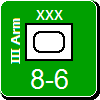kalai
Posts: 4
Joined: 11/2/2009
Status: offline

|
Wargaming the period offers the basic problem of how to portray all this in a rule set. The era certainly saw big battles such as Charles Martel's defeat of Adb-ur-Raaman at Tours, where over 100,000 men may have fought, or Yarmuk, where Khaled ibn al-Walid's Islamic force trounced a Byzantine army that may have numbered a quarter-million men. Rules like DBM, Tactica, or Armati are suitable for gaming large battles like this. But the essential feel isn't there for the smaller fights that make up the stuff of bardic verse. Many of the armies of Dark Age Europe were built around the personal followings of a warlord, what the Roman historian Tacitus called the commitatis. These groups may have numbered a few hundred at the most. In many cases they were far less numerous. The way the societies were structured allowed only a small proportion, the nobility, to bear arms. Larger forces would be made up by banding together the personal forces of lesser warlords under the leadership of a higher lord, prince, or king – though each warrior exercised personal loyalty to his lord, not necessarily to the king, and there was no concept of "country" or patriotism. Right or wrong, warriors fought for their lord and his battles were theirs. For gaming this kind of fighting, skirmish type rules work the best – especially rules that allow you to give special characteristics to individual figures who represent the warlord or some of his notable warriors. Warhammer Ancient Battles (WAB), Pig Wars, and BattleLust all provide this feel. All three rule sets use "units" to organize the forces. Pig Wars and BattleLust can be played with one unit per side allowing a relatively small numbers of figures (20 or less per side). WAB uses armies of certain points sizes that are made up of several units and so may require a hundred or more figures per side.
_________________________________________________________________________Pergola Utah Timber Frame missourihomeowner.com
|
 Printable Version
Printable Version





















 New Messages
New Messages No New Messages
No New Messages Hot Topic w/ New Messages
Hot Topic w/ New Messages Hot Topic w/o New Messages
Hot Topic w/o New Messages Locked w/ New Messages
Locked w/ New Messages Locked w/o New Messages
Locked w/o New Messages Post New Thread
Post New Thread